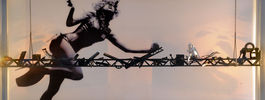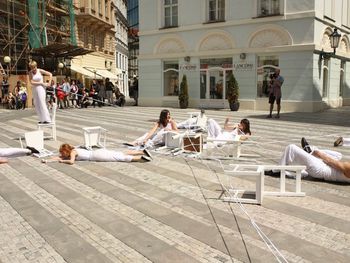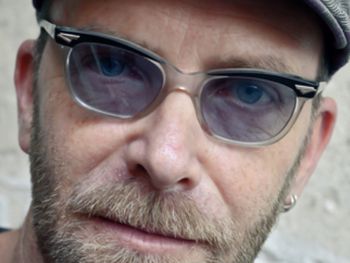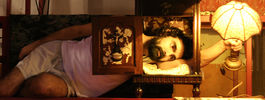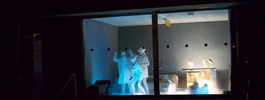Back
1971 » Poland » Stage design and costumes
| Curator: | Zenobiusz Strzelecki |
| Authors of Theme: | Zenobiusz Strzelecki |
POLSKO
The stage and costume designers we are presenting at the Prague Quadrennial 1971 appertain to the middle generation; they have started their activities in the field of plastic and graphic arts as well as in the theatrical field after 1955 the year of thaw. Today they are looked upon as masters of their craft. And in spite of it they are — with the aid of grand forms, the dramatic sense of colors, the metaphor of the composition and the structure of the materials as well as with the aid of a formative interpretation of the drama problems — incessantly searching for new means of expression resulting from the arrangement of space. This search is common to all these artists who, nevertheless, differ from one another — this fact bringing about a considerable richness of the Polish stage an costume design art. Jozef Szajna again and again creates that tragic world he became acquainted with at Auschwitz — that tattered, pierced and distressing world. He is a stage designer that interferes brutally into the dramatic work and into the actors play. In being tired with the work of stage directors imitating the life, he himself has become a stage director; hence the play-actor, the movement, the light are in his performances plastic elements just as the dramatic ones. Wojciech Krakowski is associated here with the poet Tadeusz Rozewicz, the author of the play we are presenting at the PQ 1971. The two speak the same contemporary language, the language they have figured out in the pop-art and neo-figurativeness . . . , yet just as much the language of the poetrv of our times, the poetry and philosophy of a time where the beaches are covered with rubbish, where young women are lesbians and old ladies tenderly look after the children. It is a performance that disconcerts the audience — irrespective of the apron of the scene a 1'italienne. Kazimierz Wisniak belongs to the same generation and to the same school. Recently he has been introducing into his works, being conceived according to surrealist principles, more authentic elements, in creating that way supernaturalist stage sets and costumes. The decors of L. and J. Skarzynski are in a direct connection with their surrealist book illustrations; within their stage sets the perfection of design and a special liking for the detail — that creates an unreal, but at the same time poetic environment — come into play; the properties become personages populating the scene and intermixing with the action like in the pictures of the great Rosen. Ewa Starowieyska, Zofia Pietrusinska and Krystyna Zachwatowicz are well known abroad. Their stage and costume designs excel ingenuously in color and composition; they have a great fineness as for the details that can be attained merely by women, but also a considerable masculine force as for the synthesis of the formative conception. Krzysztof Pankiewicz seems to be in vogue in the West. He is endowed with a great designer talent, but also with a vivid artistic imagination and ironic intelligence. He knows how to be poetic, yet also satiric and even perverse; he dumbfounds „the bourgeois", but he shocks the artists of the avant-garde as well. He is searching for themes in great spectacles, in experimental plays, in luxurious theatres as well as on poor stages of students' troupes. Leocadia Serafinowicz and Jan Berdyszak represent the puppetry, hence a theatre of construed personages. They lend their little mobile compositions an enormous force, being rare even in great performances of the dramatic theatres; and above all they impregnate their scenes with a purified poetry, without any aping of the life. And finailly Jerzy Ourawski, a collaborator of Jerzy Grotowski, scenographer-architect of the Theatre-Laboratory, being world-wide known. We are entirely indebted to him for that total area unity, for that sense of veracity with which he brings into effect the environment of the Constant Prince or of Faust; he creates the atmosphere, he prepares the spectator for the participation in these ritual spectacles.


Exhibiting artists / ateliers
[show all
| hide all]
- Wojciech Krakowski
Additional information: Born in 1927. Stage designer and art historian. In 1952 diplomaed at the College of Fine Arts in Cracow. Collaborates with numerous theatres. He acts as stage designer of the Stary Theatre in Cracow. His most important realizations are designs for Herr Puntila and his Servant Matti by B. Brecht, Tarelkine's Death by Suchovo- Kobyline, The Bedbug by Maiakowsky, Woyzeck by G. Büchner, Death of a Salesman by A. Miller, My Little Daughter by Róžewicz.
Obrázky z katalogu
Exhibiting works
-
Tadeusz Różewicz: (The Old Woman Hatches),
Teatr Wspolczesny
1969
- Józef Szajna
Additional information: x
Obrázky z katalogu
Exhibiting works
-
: (Purple Dust),
0
-
Aeschylus: (Oresteia ),
0
-
E. Bryll: (November Dictum),
Teatr Wyspiańskiego
(Katowice),
1969
-
T. Holuj: (Empty Field),
Teatr Ludowy
1965
-
Józef Szajna: (The Repliacation),
Teatr Studio
(Warsaw),
1973
-
Vladimir Majakovskij: (The Bathhouse),
Teatr Kameralny
(Krakow),
1967
- Kazimierz Wisniak
Additional information: Born in 1931; he graduated from the Academy of Fine Arts. He is one of the co-founders of the cabaret Piwnica in Cracow. He collaborates with various theatres in Warssw, with the J. Slowacki Theatre in Cracow, the H. Tomaszewski Pantomime at Wroclaw as well as with numerous theatres abroad, in Moscow, Kiev, Copenhagen, Helsinki, Oslo, Düsseldorf. His most significant works are the settings for Anouilh's Becket, Shakespeare's A Midsummer Night's Dream, Ostrovsky's Forest and Tchaikovsky's ballet Romeo and Juliet.
Obrázky z katalogu
- Jan Berdyszak
Additional information: Born in 1934. Stage designer, painter, sculptor, graphic artist and puppet designer. He frequently works for the Marcinek Theatre in Poznań. He participated in the PQ in 1971 and in 1979.
Obrázky z katalogu
- Jerzy Gurawski
* 1935
Specialization: architect, set designer
Additional information: In 1960 he received a diploma from the Polytechnic College, Faculty of Architecture, in Krakow. He has been collaborating with J. Grotowski at the Theatre — Laboratory in Opole, subsequently in Wroclaw. Realizations: Kordian by J. Slowacki (1962), The Tragical History of Doctor Faustus by Ch. Marlowe (1963), The Constant Prince according to Calderon (1965). The costumes for these performances have been designed by Waldemar Krygier.
Obrázky z katalogu
Exhibiting works
-
Calderón de la Barca: (The Constant Prince),
Teatr Laboratorium
1965
-
Christopher Marlowe: (The Tragical History of Doctor Faustus),
Teatr Laboratorium
1963
- Krzysztof Pankiewicz
Additional information: Born in 1933. Studied architecture at the Polytechnic School in Warsaw, painting and stage and costume design at the College of Fine Arts in Warsaw and Cracow (diplomaed in 1958). He collaborates with numerous Polish theatres (above all in Warsaw and in Cracow) and with theatres abroad (Copenhagen, Amsterdam, Oslo, Belgrade). In 1963 he was awarded the Prize of the Paris Biennial for his stage set to The Imaginary Invalid by Moliēre. He has exhibited his works in Venice, Berlin, Moscow, Amiens, Nice, Prague. He is the author of several décors for the television.
Obrázky z katalogu
Exhibiting works
-
: (The Sleeping Beauty),
0
-
A. Bloch: (The Steer),
Het Nationale Ballet
(Holland Festival),
1966
-
Jevgenij Ivanovič Zamjatin: (The Bug),
Teatr Studencki
1964
- Leokadia Serafinowicz
Additional information: Born in 1915. She studied at the Stefan Batory University in
Vilnius .In the years 1937 to 1939 and at the M. Kopernik University
in Torun between 1945 and 1948, where she graduated from
the Department of Fine Arts in 1951. Since 1948 she has worked
in various theatres for children and youth as an actress, stage
director and stage designer. She now also teaches at the College
of Theatrical Arts in Wroclaw. Her most interesting stage designs
include productions of J. Ratajczek' s Nightingale, V.
Mayakovski´s The Bath, J. Potocki' s Les parades, C. K. Nor -
wiď s Wanda, J. Kurczewski' s and M. Kownacka' s Lajkonik, M.
Bialoszewski' s Mrs Koch and K. Milobedzka' s A Tale Of . ..
She received the 2nd Prize at the Polish National Festival of Puppet Theatres in Warsaw in 1965, the 1st Prize at the Polish
National Festival of Puppet Theatres in Opole in 1971, a Gold
Medal at the 2nd Prague Quadrennial of Theatre Design in 1971,
a 1st Prize at the 1st Biennial of Art for Children in Poznan
in 1971, and the 1st Prize at the 3rd Biennial of Art for Children
in Poznan in 1975. She has also been awarded the Order of the
Smile.
Obrázky z katalogu
Exhibiting works
-
M. Kownacka - J. Kurczewski: (Lajkronik),
Teatr lalki i aktora
1969
- Lidia
Jerzy Skarzynska
Skarzynski
Additional information: Both studied at the Academy of Fine Arts in Cracow, at the Polytechnic
and the Film Institute. They made their debut in 1948
at the Groteska Puppet Theatre. They work mainly with the Stary
Teatr in Cracow and with several theatres abroad. At present
they also teach stage and film design at the Academy of Fine
Arts in Cracow. Their most significant work in recent years in -
cludes the sets and costumes for Marlowe' s Dr Faustus, Strindberg' s
Miss Julie, Becketť s Waiting for Godot, Verdi' s The
Masqued Ball and Mozart' s La Clemenza di Tito. Jerzy Skarzynski
is also a painter, book illustrator and designs for films.
Obrázky z katalogu
Exhibiting works
-
J. Joyce - Z. Hubner : (Ulysses),
Teatr Wybrzeze
1969
- Ewa Starowieyska
Additional information: In 1956 diplomaed on stage and costume design at the College of Fine Arts in Warsaw. She is at work as stage designer of the theatre Teatr Wspólczesny in Warsaw vhere she has, among others, brought into effect sets for: The Résistible Ascension of Arturo Ui by B. Brecht, Tango by Mrožek, The Three Sisters by A. P. Chekhov; at the Teatr Polski: The Pedestrian in the Air by E. Ionesco; at the Ateneum Theatre: The Blacks by J. Genêt; at the Teatr Dramatyczny: Frank V, The Physicists, The Angel Descends Over Babylon; in Berlin: The Bedburg, in Düsseldorf: Tango, The Three Sisters, Androcles and the Lion; in Wuppertal: The Maids by Genêt, Woyzeck by Büchner, the ballets by Mozart and Hindemith; in Leningrad: Two Theatres by Szaniawski and The Resistible Ascension of Arturo Ui. E. Starowieyska is also an author of scenic designs for the television and the film.
Obrázky z katalogu


